
Top 9 Interesting MLflow Project Ideas to Explore in Data Science
Oct 22, 2024 6 Min Read 5967 Views
(Last Updated)
Collaboration is a key factor for an organization or a business to run successfully, especially in the field of technology. In that sense, data scientists and machine learning engineers must collaborate to improve efficiency.
To do that, they’ll be using a tool called MLflow. If you are already using it or new to it, you can learn it by simply implementing MLflow project ideas.
If you don’t know where to start, worry not, you have already started by clicking on this article as this will cover 9 interesting and unique MLflow project ideas to get you started.
So, without any delay, let’s get started on MLflow project ideas!
Table of contents
- Why is MLflow important in Data Science and Machine Learning?
- MLflow Project Ideas to Explore in Data Science
- Experiment Tracking for Hyperparameter Tuning
- Model Versioning and Deployment
- Reproducible Machine Learning Pipelines
- Automated Machine Learning (AutoML) Integration
- End-to-End ML Pipeline with MLflow and Kubernetes
- Time Series Forecasting with MLflow
- Image Classification with Transfer Learning and MLflow
- Natural Language Processing (NLP) Pipeline with MLflow
- Anomaly Detection in IoT Sensor Data with MLflow
- Conclusion
- FAQs
- Can MLflow be integrated with other machine learning frameworks?
- What kind of metrics can MLflow track during experiments?
- Can MLflow be used with cloud services for model deployment?
- What are the core components of MLflow?
Why is MLflow important in Data Science and Machine Learning?
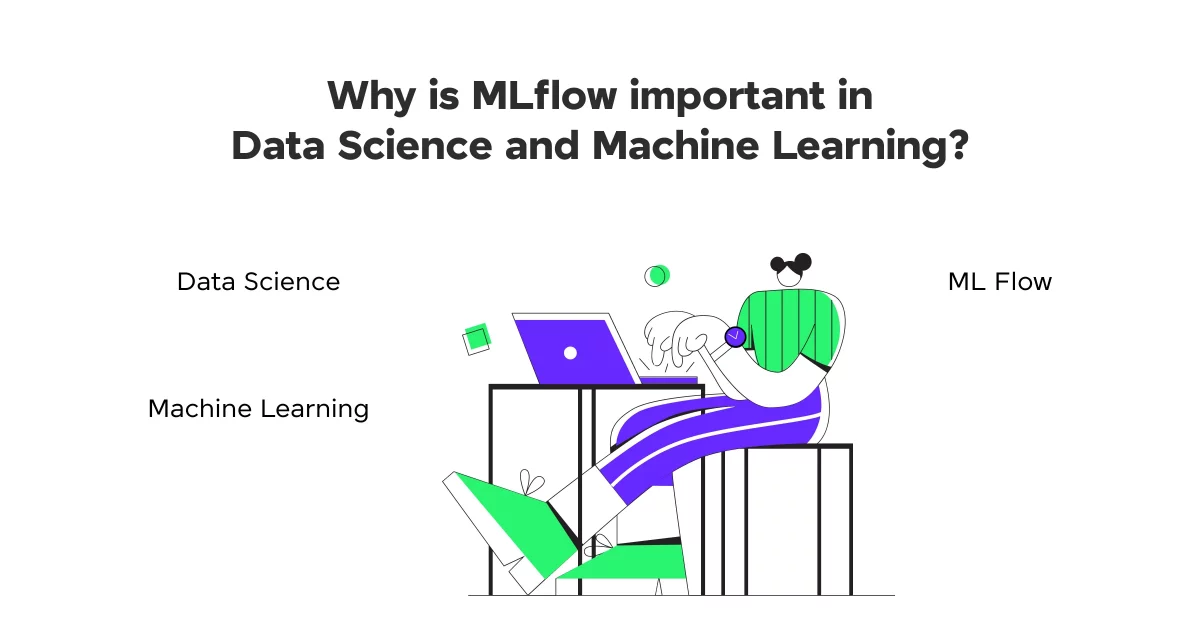
Before we see the MLflow project ideas, let us first see why we have to use MLflow in machine learning and why it is important!
MLflow is an open-source tool that helps data scientists and machine learning engineers manage their work more efficiently. Think of it as a project manager for machine learning projects. Here’s how it helps:
- Tracking Experiments: MLflow helps you record all the experiments, so you can easily see which combination worked best.
- Packaging Models: MLflow helps you package your machine learning models so others can use them without any confusion.
- Managing Models: MLflow helps you manage different versions of your models, so you always know which one to use.
- Deploying Models: MLflow helps you deploy your machine learning models to different platforms so they can be used in real-world applications.
In simple terms, MLflow makes it easier to organize, track, and share your machine-learning projects by using previous data and this data is gathered with the help of data scientists.
That is why, you are going to master MLflow with the help of these MLflow project ideas!
Learn More: Machine Learning Must-Knows: Reliable Models and Techniques
MLflow Project Ideas to Explore in Data Science
We have seen the basics about MLflow in the previous section and now it is time for us to jump right into the topic that is, MLflow project ideas.
But before seeing MLflow project ideas, make sure you are thorough with the basics of machine learning. If not, consider enrolling for a professionally certified online Artificial Intelligence & Machine Learning course that would help you strengthen your basics along with an industry-grade certificate.
Whether you’re a data scientist, machine learning engineer, or a hobbyist who’s just getting started, here are some exciting MLflow project ideas to get you started.
1. Experiment Tracking for Hyperparameter Tuning
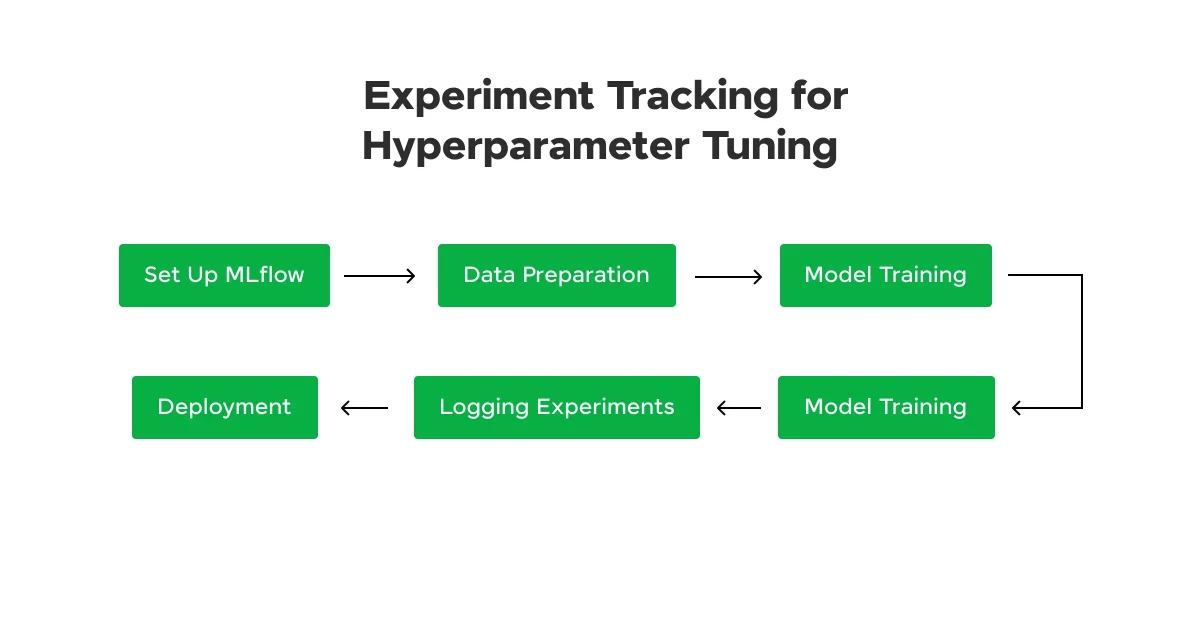
First in our list of MLflow project ideas is Hyperparameter tuning which is crucial for optimizing machine learning models.
Tracking these experiments can be challenging, especially when dealing with multiple models and configurations. MLflow’s experiment tracking feature allows you to log parameters, code versions, metrics, and output files.
Project Idea
- Objective: Optimize the hyperparameters of a classification model (e.g., Random Forest) on a dataset such as the Titanic dataset.
- Steps:
- Set Up MLflow: Install MLflow and configure it to track your experiments.
- Data Preparation: Preprocess the Titanic dataset.
- Model Training: Train a Random Forest classifier with different hyperparameters.
- Logging Experiments: Use MLflow to log parameters (e.g., number of trees, max depth), metrics (e.g., accuracy, F1 score), and model artifacts.
- Analysis: Compare the logged results to find the best hyperparameter combination.
Benefits
- Understand the impact of different hyperparameters on model performance.
- Learn how to effectively track and analyze experiments.
Also Read: Real-World Machine Learning Applications
2. Model Versioning and Deployment
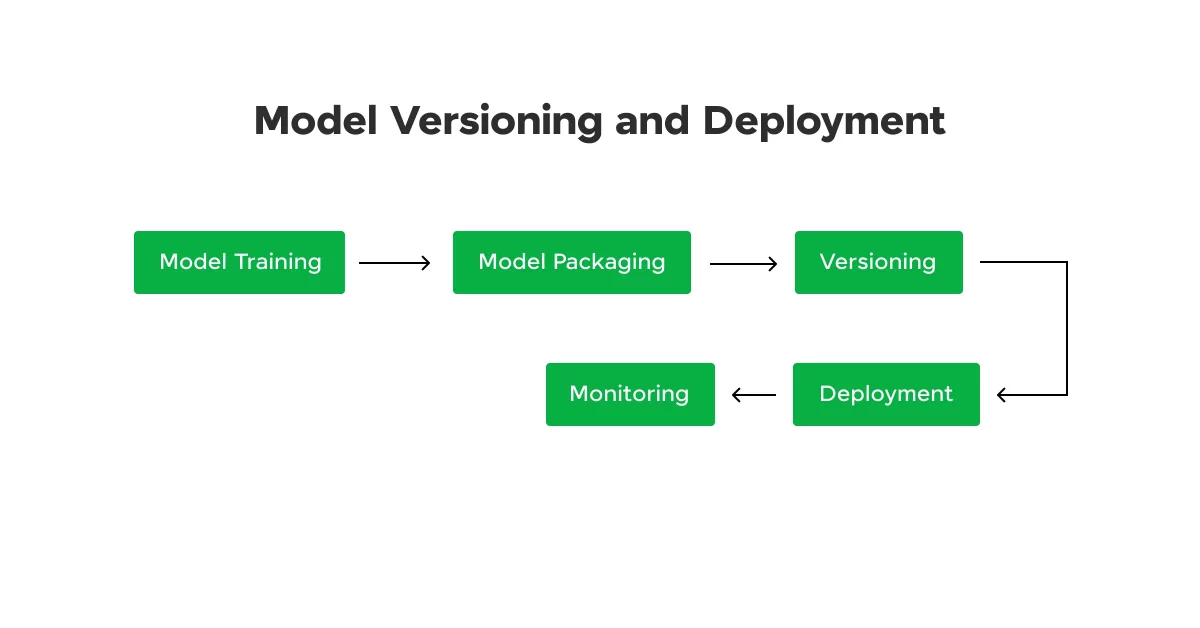
Managing model versions and deploying them efficiently is critical in a production environment and that is why we are going to see model versioning as our second idea in MLflow project ideas.
MLflow Models offers a way to package models in a reusable format that can be shared and deployed across different environments. This is a crucial yet simple idea in the list of MLflow project ideas that lets you master both MLflow and version control.
Project Idea
- Objective: Create a versioned model deployment pipeline using MLflow for a regression task, such as predicting house prices.
- Steps:
- Model Training: Train multiple versions of a regression model (e.g., Linear Regression) on a house prices dataset.
- Model Packaging: Use MLflow to package the trained models.
- Versioning: Assign version numbers to each model iteration.
- Deployment: Deploy the best model version using MLflow’s deployment tools (e.g., MLflow REST API or cloud services like AWS Sagemaker).
- Monitoring: Set up monitoring to track the deployed model’s performance over time.
Benefits
- Gain experience in model version control and deployment.
- Learn to monitor deployed models in a real-world scenario.
Explore: Mastering Advanced Git: An In-Depth Guide to Efficient Version Control
3. Reproducible Machine Learning Pipelines
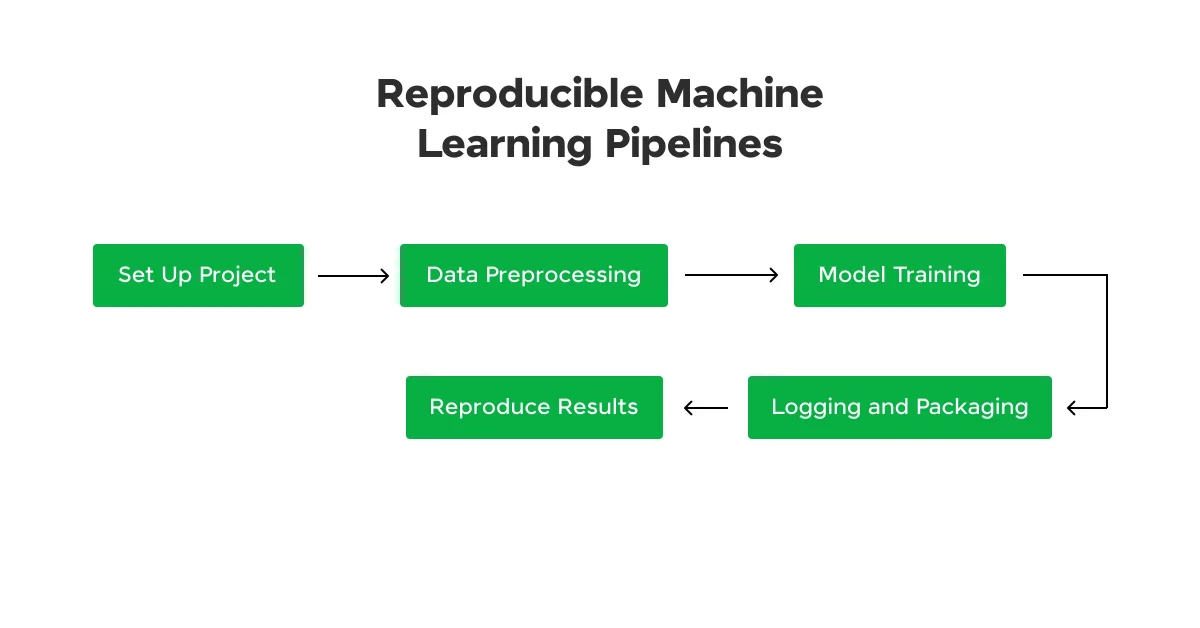
Reproducibility is a one-of-a-kind innovative model in reliable machine learning. MLflow project ideas facilitate the creation of reproducible ML workflows by defining them in a standardized way.
Project Idea
- Objective: Develop a reproducible ML pipeline for a text classification task, such as sentiment analysis on movie reviews.
- Steps:
- Set Up Project: Define the MLflow project structure, including the conda environment and entry points.
- Data Preprocessing: Implement text preprocessing steps (e.g., tokenization, stemming).
- Model Training: Train a text classification model (e.g., Logistic Regression) on the preprocessed data.
- Logging and Packaging: Log the project details and package the model using MLflow.
- Reproduce Results: Share the project with others and ensure they can reproduce the results by following the project structure.
Benefits
- Ensure your ML experiments are reproducible by others.
- Understand the importance of structured project workflows in collaborative environments.
Know More: Top 9 Machine Learning Project Ideas For All Levels [with Source Code]
4. Automated Machine Learning (AutoML) Integration
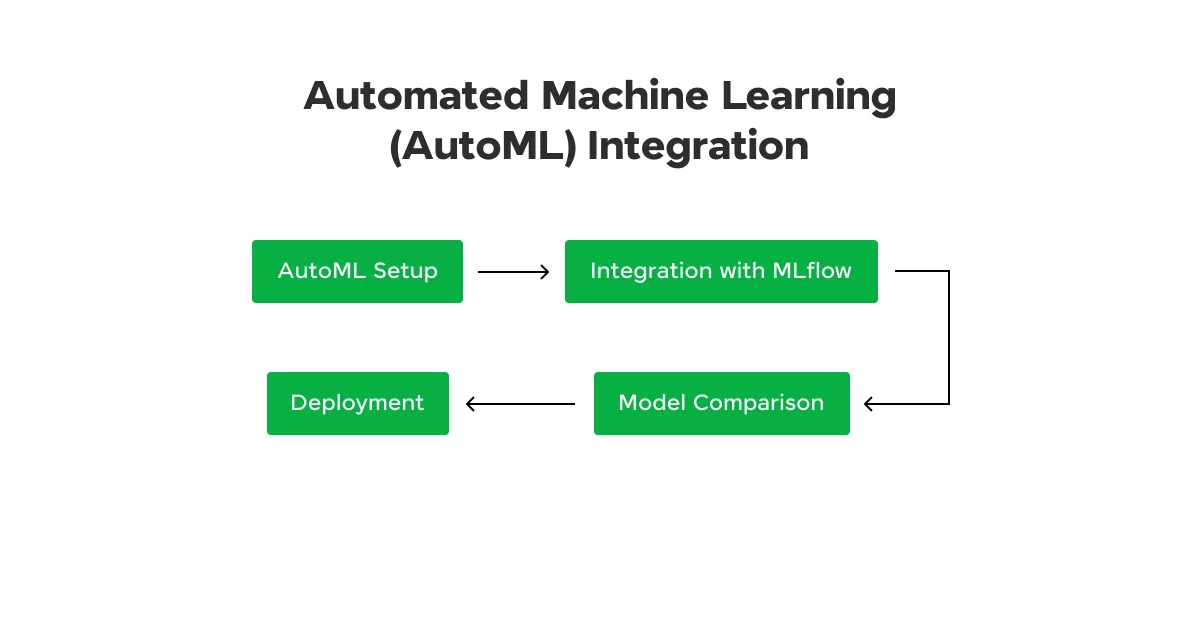
Automated Machine Learning (AutoML) tools can automate the end-to-end process of applying machine learning to real-world problems.
In this list of MLflow project ideas, we have an automated machine learning tool that works by integrating AutoML with MLflow to streamline experiment tracking and model management.
Project Idea
- Objective: Use an AutoML tool (e.g., H2O.ai, Auto-sklearn) to automate the model selection and hyperparameter tuning process on a dataset like the Boston Housing dataset.
- Steps:
- AutoML Setup: Configure and run an AutoML tool on the dataset.
- Integration with MLflow: Modify the AutoML pipeline to log experiments, parameters, and models to MLflow.
- Model Comparison: Analyze the logged results to identify the best-performing model.
- Deployment: Deploy the best model using MLflow.
Benefits
- Explore the efficiency of AutoML tools in model development.
- Learn how to integrate AutoML outputs with MLflow for better experiment management.
Also, Find Out 7 Unique Machine Learning Capstone Projects To Boost Your Resume
5. End-to-End ML Pipeline with MLflow and Kubernetes
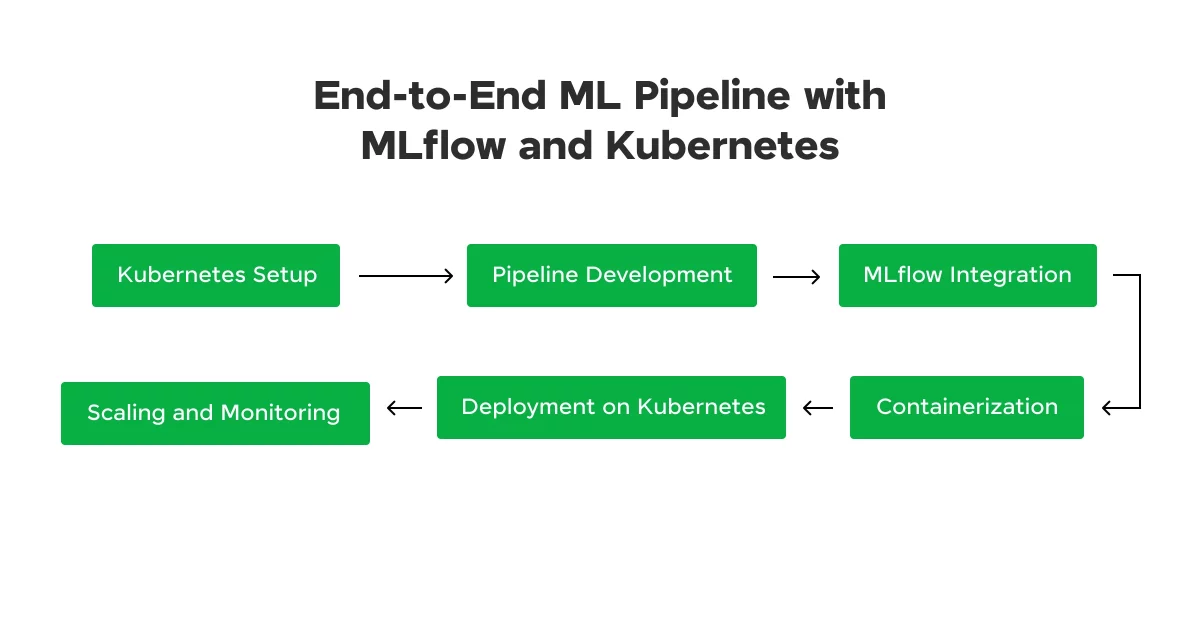
Deploying machine learning models at scale often requires a robust infrastructure. That is why, in the MLflow project ideas list, we have a project that lets you combine MLflow with Kubernetes and can provide a scalable solution for managing ML workflows.
Project Idea
- Objective: Build an end-to-end ML pipeline that includes data ingestion, preprocessing, model training, and deployment on a Kubernetes cluster.
- Steps:
- Kubernetes Setup: Set up a Kubernetes cluster.
- Pipeline Development: Develop an ML pipeline for a specific use case (e.g., image classification).
- MLflow Integration: Integrate MLflow for tracking experiments and managing models.
- Containerization: Containerize the ML components using Docker.
- Deployment on Kubernetes: Deploy the containerized components on the Kubernetes cluster.
- Scaling and Monitoring: Implement scaling policies and monitoring tools to ensure the pipeline’s reliability.
Benefits
- Gain hands-on experience with Kubernetes for deploying ML models.
- Learn to build scalable and reliable ML workflows.
Explore More: 10 Interesting Data Science Kubernetes Projects To Upskill Your Knowledge
6. Time Series Forecasting with MLflow
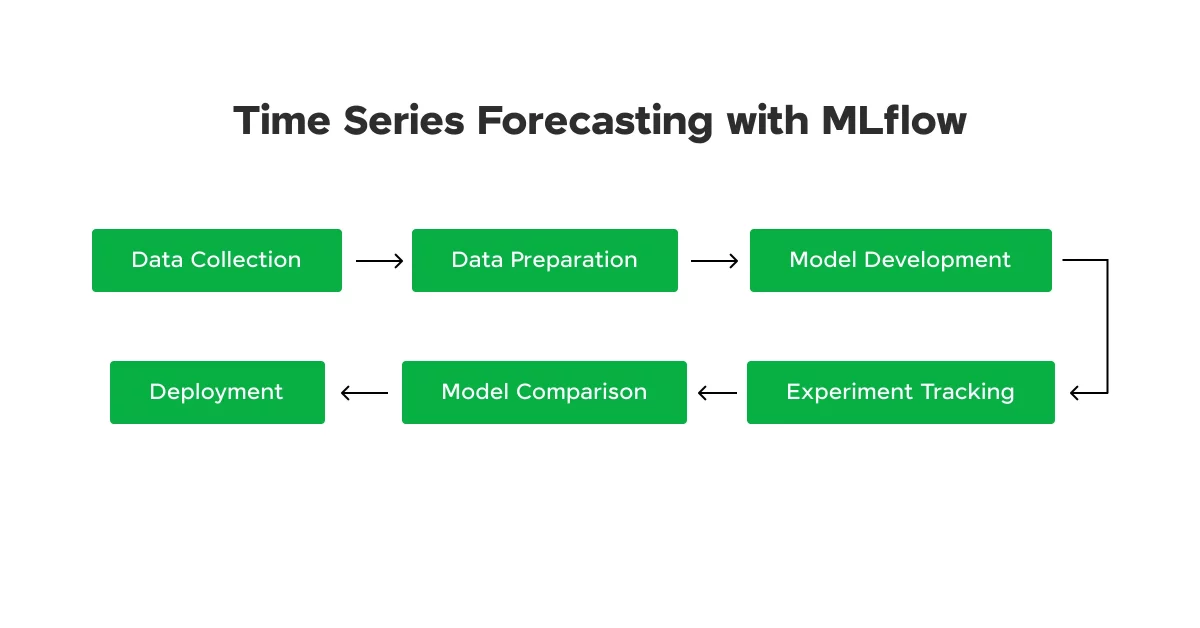
Moving on, let us jump into our next one on the list of MLflow project ideas. Time series forecasting is a critical task in many domains, such as finance, supply chain management, and weather prediction.
That is why we have a time series forecaster in our list of MLflow project ideas that can help manage the complexities of tracking experiments and deploying models for time series forecasting.
Project Idea
- Objective: Build and track a time series forecasting model for predicting stock prices.
- Steps:
- Data Collection: Gather historical stock price data.
- Data Preparation: Perform necessary preprocessing steps like handling missing values, feature engineering, and scaling.
- Model Development: Develop and train a time series forecasting model (e.g., ARIMA, LSTM).
- Experiment Tracking: Use MLflow to log parameters (e.g., window size, number of layers), metrics (e.g., RMSE, MAE), and model artifacts.
- Model Comparison: Analyze and compare different models and configurations.
- Deployment: Deploy the best-performing model using MLflow.
Benefits
- Learn to handle and preprocess time series data.
- Gain experience in building and deploying forecasting models.
- Understand the importance of tracking and comparing different time series models.
7. Image Classification with Transfer Learning and MLflow
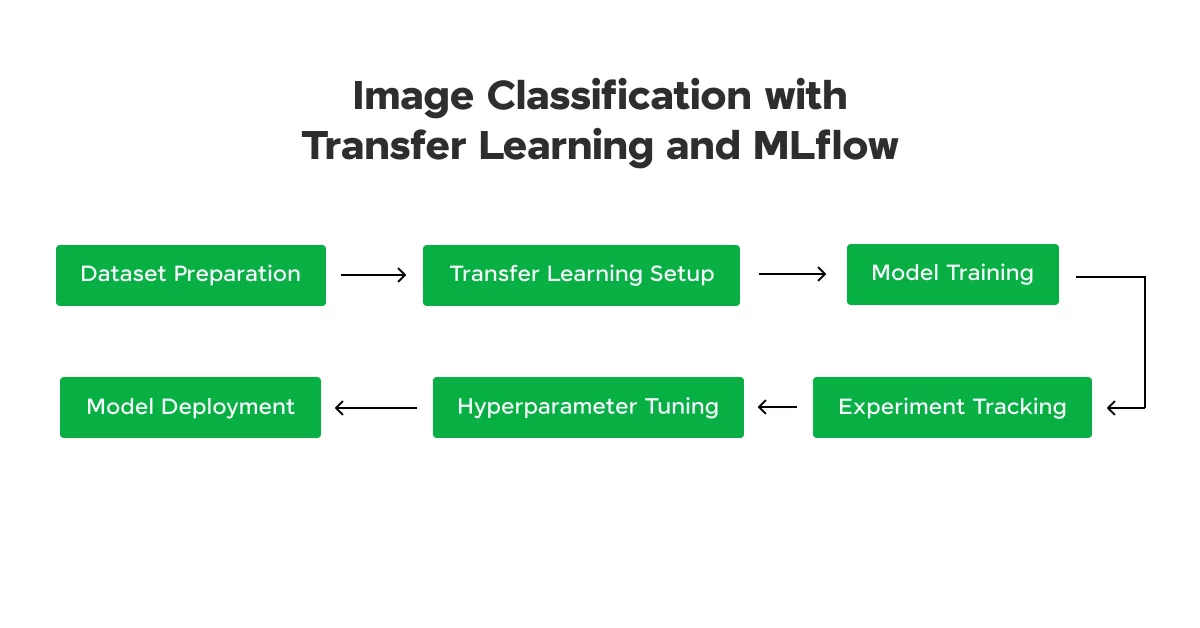
Next on our list of MLflow project ideas, we have image classification. Transfer learning is a powerful technique in deep learning, where a pre-trained model is fine-tuned on a new dataset.
MLflow can facilitate the tracking and management of experiments involving transfer learning.
Project Idea
- Objective: Use transfer learning to build an image classification model for classifying different species of flowers.
- Steps:
- Dataset Preparation: Use a dataset like the Flowers-102 dataset.
- Transfer Learning Setup: Choose a pre-trained model (e.g., ResNet50) and set up the transfer learning pipeline.
- Model Training: Fine-tune the pre-trained model on the flower dataset.
- Experiment Tracking: Log parameters (e.g., learning rate, number of epochs), metrics (e.g., accuracy, loss), and model artifacts using MLflow.
- Hyperparameter Tuning: Experiment with different hyperparameters and track the results.
- Model Deployment: Deploy the fine-tuned model using MLflow.
Benefits
- Understand the principles and applications of transfer learning.
- Learn how to fine-tune pre-trained models for specific tasks.
- Gain experience in tracking and managing complex experiments with MLflow.
8. Natural Language Processing (NLP) Pipeline with MLflow
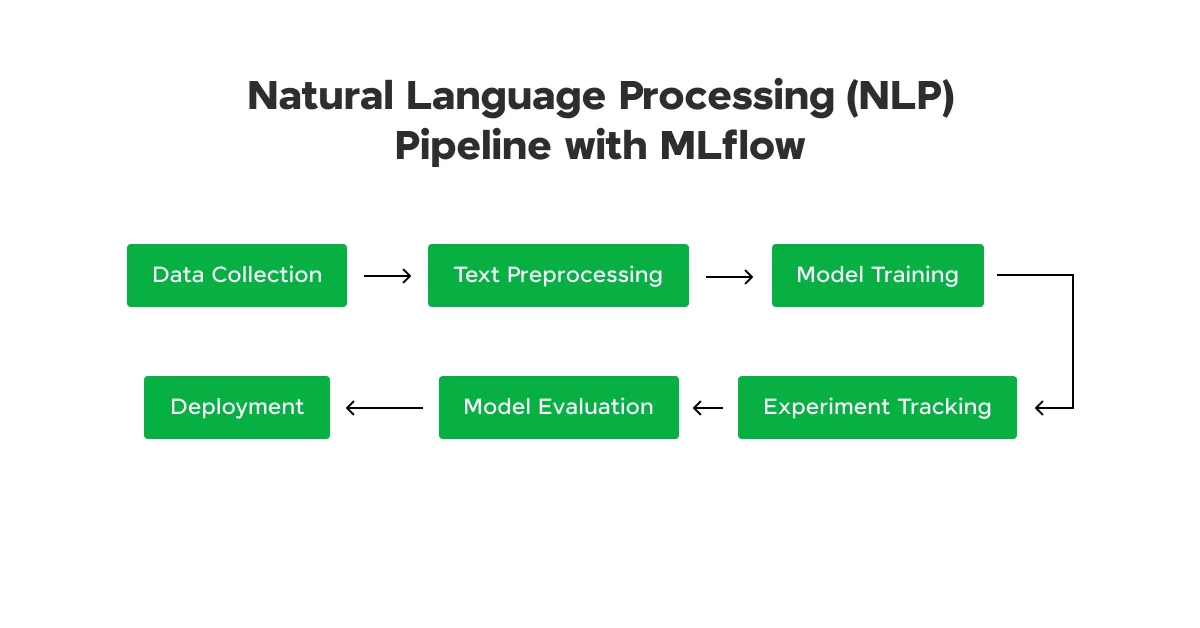
NLP tasks, such as text classification or sentiment analysis, involve multiple steps including data preprocessing, model training, and evaluation. So, for that, we have an NLP pipeline project in this list of interesting MLflow project ideas.
Project Idea
- Objective: Develop an NLP pipeline to classify the sentiment of movie reviews.
- Steps:
- Data Collection: Use a dataset like the IMDb movie reviews dataset.
- Text Preprocessing: Implement preprocessing steps such as tokenization, stop-word removal, and vectorization (e.g., TF-IDF or word embeddings).
- Model Training: Train an NLP model (e.g., LSTM, BERT) on the preprocessed data.
- Experiment Tracking: Use MLflow to log parameters (e.g., learning rate, batch size), metrics (e.g., accuracy, F1 score), and model artifacts.
- Model Evaluation: Evaluate the model on a test set and log the results.
- Deployment: Deploy the model using MLflow and create an API endpoint for real-time sentiment analysis.
Benefits
- Gain experience with text preprocessing techniques.
- Learn to build and evaluate NLP models.
- Understand how to deploy NLP models for real-time applications.
Learn More: Basics of NLP: A Beginner’s Guide to Natural Language Processing
9. Anomaly Detection in IoT Sensor Data with MLflow
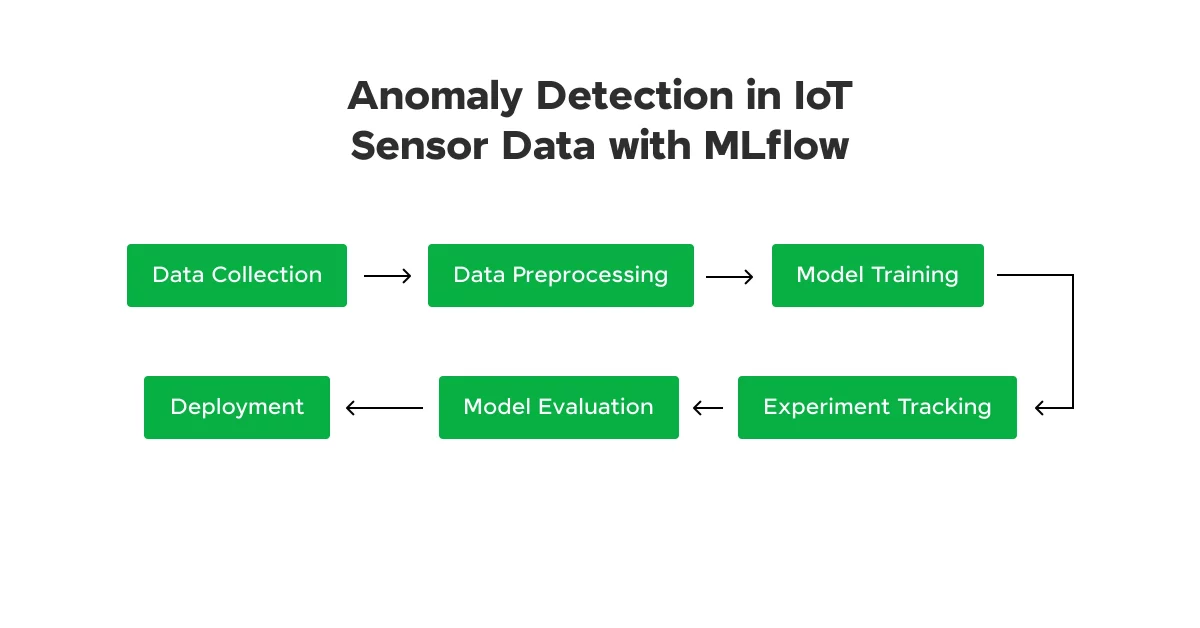
Last but not least, we have anomaly detection in this list of MLflow project ideas. Anomaly detection is essential in various fields, such as manufacturing and cybersecurity, to identify abnormal patterns that could indicate potential issues.
MLflow can help manage the development and deployment of anomaly detection models.
Project Idea
- Objective: Develop an anomaly detection model for IoT sensor data to identify potential equipment failures.
- Steps:
- Data Collection: Use a dataset containing IoT sensor readings (e.g., temperature, pressure).
- Data Preprocessing: Clean and preprocess the data, handling missing values and normalizing the readings.
- Model Training: Train an anomaly detection model (e.g., Isolation Forest, Autoencoder).
- Experiment Tracking: Use MLflow to log parameters (e.g., contamination rate, number of estimators), metrics (e.g., precision, recall), and model artifacts.
- Model Evaluation: Evaluate the model on a labeled dataset with known anomalies and log the results.
- Deployment: Deploy the anomaly detection model using MLflow and set up monitoring to alert when anomalies are detected.
Benefits
- Understand the importance of anomaly detection in IoT applications.
- Learn to preprocess and handle sensor data.
- Gain experience in deploying and monitoring anomaly detection models.
These MLflow project ideas will help you further explore the capabilities of MLflow in different domains, enhancing your skills in managing and deploying machine learning projects effectively.
If you want to learn more about MLflow and Machine Learning, then consider enrolling in
GUVI’s Certified Artificial Intelligence & Machine Learning Course not only gives you theoretical knowledge but also practical knowledge with the help of real-world projects.
Also Read: Top 10 Steps to Kickstart Your Career as a Machine Learning Engineer
You can also find some more MLFlow project ideas.
Conclusion
In conclusion, these diverse MLflow project ideas like hyperparameter tuning, model deployment, and NLP pipelines equip you with essential skills for managing the machine learning lifecycle effectively.
Whether optimizing models or ensuring reproducibility, these MLflow project ideas offer robust tools to streamline your workflow.
These MLflow project ideas not only enhance your technical expertise but also prepare you for real-world applications. By diving into these MLflow project ideas, you’ll gain valuable experience in experiment tracking, model management, and deployment.
Also Explore: Top 10 Product-Based Companies for Machine Learning Freshers 2024
FAQs
1. Can MLflow be integrated with other machine learning frameworks?
Yes, MLflow supports integration with various ML frameworks like TensorFlow, PyTorch, Scikit-Learn, and more, allowing seamless tracking and management of experiments across different environments.
2. What kind of metrics can MLflow track during experiments?
MLflow can track metrics such as accuracy, precision, recall, loss, RMSE, and custom metrics defined by the user, providing comprehensive insights into model performance.
3. Can MLflow be used with cloud services for model deployment?
Yes, MLflow integrates with various cloud services like AWS, Azure, and Google Cloud, facilitating seamless deployment and scaling of ML models in the cloud.
4. What are the core components of MLflow?
MLflow consists of four components: MLflow Tracking, MLflow Projects, MLflow Models, and MLflow Registry, each serving a specific function in managing the ML lifecycle.























![10 Impressive Docker Project Ideas [With Source Code] 12 Docker Project Ideas](https://www.guvi.in/blog/wp-content/uploads/2024/11/Docker-Project-Ideas.webp)
![10 Unique VueJS Project Ideas [With Source Code] 13 VueJS Project Ideas](https://www.guvi.in/blog/wp-content/uploads/2024/11/VueJS-Project-Ideas.webp)
![10 Brilliant Hadoop Project Ideas [With Source Code] 14 Hadoop Project Ideas](https://www.guvi.in/blog/wp-content/uploads/2024/11/Hadoop-Project-Ideas.webp)


![10 Incredible PyTorch Project Ideas [With Source Code] 17 PyTorch Project Ideas](https://www.guvi.in/blog/wp-content/uploads/2024/11/Feature-image.png)
![10 Unique Deep Learning Project Ideas [With Source Code] 18 Deep Learning Project Ideas](https://www.guvi.in/blog/wp-content/uploads/2024/10/DeepLearning_Project_Ideas.png)
![10 Impressive Data Visualization Project Ideas [With Source Code] 19 Data Visualization Project Ideas](https://www.guvi.in/blog/wp-content/uploads/2024/11/best_data_visualization_project_ideas_with_source_code_.webp)
![Top 10 Ruby on Rails Project Ideas [With Source Code] 20 Ruby on Rails Project Ideas](https://www.guvi.in/blog/wp-content/uploads/2024/10/Ruby_on_Rails_Project_Ideas.png)
Did you enjoy this article?